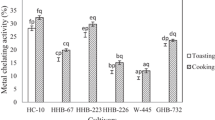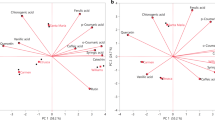Abstract
All the pea varieties differed significantly (p<0.05) in their phytic acid content. The field pea cultivars had significantly (p<0.05) higher levels of phytic acid and polyphenols than those of vegetable pea varieties. All the domestic processing and cooking methods could reduce the contents of phytic acid and polyphenols but germination for 48 hours seemed to have a marked lowering effect on the levels of these antinutrients in peas.
Similar content being viewed by others
References
Ali HI, Harland BF (1991) Effect of fibre and phytate in sorghum flour on iron and zinc in weanling rats: A pilot study. Cereal Chem 68: 37–41.
Deshpande SS, Cheryan M (1984) Effect of phytic acid divalent cations and their interactions on alpha amylase activity. J Food Sci 49: 516–519.
Hernandez T, Hernandez A, Martinez C (1991) Polyphenols in alfalfa leaf concentrates. J Agric Food Chem 38: 1120–1122.
Thompson LU, Yoon JH (1984) Starch digestibility as affected by polyphenols and phytic acid. J Food Sci 49: 1228–1229.
Davies NT, Reid H (1979) An evaluation of phytate, zinc, copper, iron and manganese content and zinc availability from soybased textured vegetable protein meat substitutes or meat extrudes. Br J Nutr 41: 579–589.
Singh U, Jambunathan R (1981) Studies on desi and Kabuli chick pea cultivars: The levels of protease inhibitors, level of polyphenolic compounds and in vitro digestibility. J Food Sci 46: 1364–1367.
Panse YG, Sukhatme PV (1961) Statistical methods of agricultural workers. New Delhi: Indian Council of Agricultural Research, pp. 12, 87.
Elkowiez K, Sosulski FW (1982) Antinutritive factors in eleven legumes and their air-classified protein and starch fractions. J Food Sci 47: 1301–1304.
Kumar V, Kapoor AC (1983) Availability of zinc as affected by phytate. Nutr Rep Int 28: 103–111.
Manan F, Hussain T, Ali I, Iqbal P (1987) Effect of cooking on phytic acid and nutritive value of Pakistani peas and lentils. Food Chem 23: 81–87.
Deshpande SS, Cheryan M (1983) Changes in the phytic acid, tannins and trypsin inhibitor activity on soaking of dry beans (P. vulgaris L.). Nutr Rep Int 27: 371–378.
Ologhobo AD, Fetuga BL (1984) Distribution of phosphorous and phytate in some Nigerian varieties of legumes and some affects of processing. J Food Sci 49: 199–201.
Kumar KG, Venkaraman LV, Jaya TV, Krishnamurthy KS (1978) Cooking characteristics of some germinated legumes: Changes in phytins, Ca++, Mg++ and pectins. J Food Sci 43: 85–89.
Khokhar S (1984) Studies on nutrient composition and antinutritional factors of moth bean (Vigna aconitifolia). MSc Thesis, Haryana Agricultural University, Hisar, India.
Sharma A (1989) Effect of processing and cooking methods on nutrient composition and antinutritional factors of Bakla (Vicia faba). MSc Thesis. Haryana Agricultural University, Hisar, India.
Lolas GM, Markakis P (1975) Phytic acid and other phosphorous compounds of beans. J Agric Food Chem 23: 13–15.
Mandal NC, Burmans S, Biswas BB (1972) Isolation, purification and characterizations of phytase from germinating mung beans. Phyto Chem 11: 495–502.
Kataria A, Chauhan, BM and Punia, D (1989) Antinutrients and protein digestibility (in vitro) of mungbean as affected by domestic processing and cooking. Food Chem 32: 9–17.
Jood S, Chauhan BM, Kapoor AC (1987) Polyphenols in chickpea and black gram as affected by domestic processing and cooking methods. J Sci Food Agric 38: 145–149.
Rao PU, Deosthale YG (1982) Tannin content of pulses: varietal differences and effects of germination and cooking. J Sci Food Agric 33: 1013–1016.
Author information
Authors and Affiliations
Rights and permissions
About this article
Cite this article
Bishnoi, S., Khetarpaul, N. & Yadav, R.K. Effect of domestic processing and cooking methods on phytic acid and polyphenol contents of pea cultivars (Pisum sativum). Plant Food Hum Nutr 45, 381–388 (1994). https://doi.org/10.1007/BF01088088
Received:
Accepted:
Issue Date:
DOI: https://doi.org/10.1007/BF01088088




